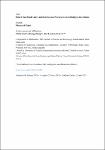Role of dual breakwaters and trenches on efficiency of an oscillating water column
| dc.contributor.author | Naik, N | |
| dc.contributor.author | Zheng, Siming | |
| dc.contributor.author | Behera, H | |
| dc.date.accessioned | 2023-04-17T22:57:23Z | |
| dc.date.available | 2023-04-17T22:57:23Z | |
| dc.date.issued | 2023-04-12 | |
| dc.identifier.issn | 1070-6631 | |
| dc.identifier.issn | 1089-7666 | |
| dc.identifier.other | ARTN 047115 | |
| dc.identifier.uri | https://pearl.plymouth.ac.uk/handle/10026.1/20722 | |
| dc.description.abstract |
In this paper, the effects of double-submerged breakwaters and trenches on the hydrodynamic performance of an oscillating water column (OWC) are investigated. The multi-domain boundary element method is used to tackle the physical problem of wave scattering and radiation from the device. The role of the height of the breakwaters, depth of the trenches, width of the breakwaters and trenches, spacing between the structures, length of the OWC chamber, and other wave and structural parameters is investigated on the efficiency of OWC. The study reveals that there is an oscillating pattern of the efficiency curve in the presence of single or double breakwater/trenches; this pattern is absent when the bottom is flat. Moreover, compared to single or no breakwaters/trenches, the occurrence of full OWC efficiency is higher in the presence of double breakwaters/trenches. Furthermore, the amplitude of the oscillating pattern in the efficiency curve increases with an increase in the height and depth of the breakwaters and trenches, respectively. For some particular wave and structural parameters, zero OWC efficiency occurs nearly 𝑘0ℎ=3.4 within 0<𝑘0ℎ<5 (k0 wave number and h water depth). This zero efficiency moves toward small wave numbers as the spacing between OWC and rigid breakwater/trench increases. The radiation conductance of OWC decreases with an increase in the barrier height. The findings outline the structural criteria that can be employed to build and deploy an effective OWC device. | |
| dc.format.extent | 047115-047115 | |
| dc.language | en | |
| dc.publisher | AIP Publishing | |
| dc.title | Role of dual breakwaters and trenches on efficiency of an oscillating water column | |
| dc.type | journal-article | |
| dc.type | Journal Article | |
| plymouth.author-url | https://www.webofscience.com/api/gateway?GWVersion=2&SrcApp=PARTNER_APP&SrcAuth=LinksAMR&KeyUT=WOS:000970360900006&DestLinkType=FullRecord&DestApp=ALL_WOS&UsrCustomerID=11bb513d99f797142bcfeffcc58ea008 | |
| plymouth.issue | 4 | |
| plymouth.volume | 35 | |
| plymouth.publication-status | Published | |
| plymouth.journal | Physics of Fluids | |
| dc.identifier.doi | 10.1063/5.0146004 | |
| plymouth.organisational-group | |Plymouth | |
| plymouth.organisational-group | |Plymouth|Faculty of Science and Engineering | |
| plymouth.organisational-group | |Plymouth|Faculty of Science and Engineering|School of Engineering, Computing and Mathematics | |
| plymouth.organisational-group | |Plymouth|REF 2021 Researchers by UoA | |
| plymouth.organisational-group | |Plymouth|Users by role | |
| plymouth.organisational-group | |Plymouth|Users by role|Academics | |
| plymouth.organisational-group | |Plymouth|REF 2021 Researchers by UoA|UoA12 Engineering | |
| dcterms.dateAccepted | 2023-03-25 | |
| dc.date.updated | 2023-04-17T22:57:09Z | |
| dc.rights.embargodate | 2023-4-19 | |
| dc.identifier.eissn | 1089-7666 | |
| dc.rights.embargoperiod | forever | |
| rioxxterms.versionofrecord | 10.1063/5.0146004 |


